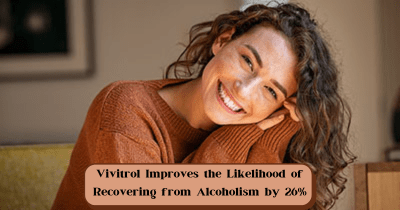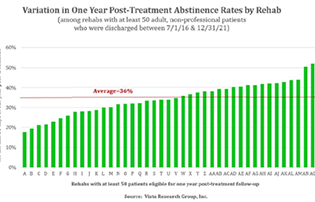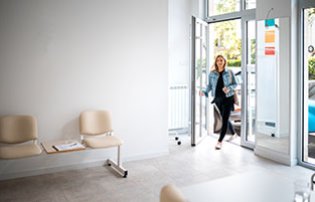
When my daughter was guzzling enough vodka to potentially kill herself night after night, I desperately wished there was a magic pill we could give her that would help her stop drinking. We decided against putting her on Antabuse, which would make her throw up if she drank, and she refused to go on Suboxone because she’d heard bad things about its withdrawal. Those were the only choices we were aware of in 2008-2012.
So it brings me great pleasure to report that Vista’s independent, real-world research shows that taking Vivitrol, a monthly naltrexone injection by Alkermes, significantly increases the likelihood that someone with alcohol use disorder (AUD) will not be drinking one year after treatment.
Patients who Leave Treatment on Vivitrol are 26% More Likely to be Abstinent One Year Later
In Vista’s research, 52% of AUD patients who were taking Vivitrol and no other SUD medications when they left treatment were reachable and reported not having used any drugs or alcohol for at least the last 30 days at one year post-treatment:
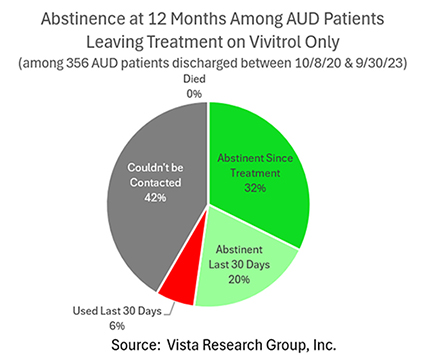
By comparison, only 41% of AUD patients who are not taking any medication on their last survey before leaving treatment reported being abstinent one year later:
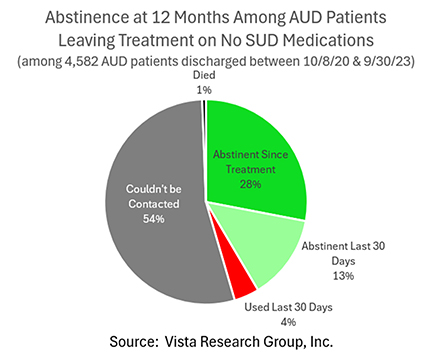
Interestingly, the 45% abstinence rate of patients who were taking a daily pill of Vivitrol’s active ingredient, Naltrexone, on their last during-treatment survey was part-way between the two:
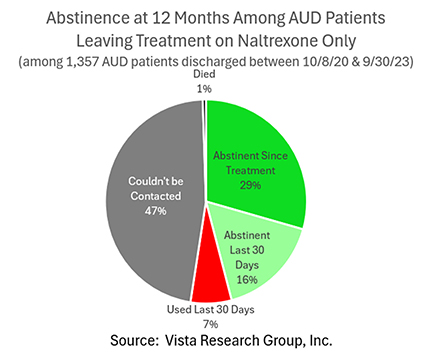
Compared to AUD patients who were not taking medication when they left treatment, those taking Vivitrol were 26% more likely to report abstaining from alcohol or non-prescribed drugs for at least the last 30 days one year after leaving treatment. AUD patients who were taking naltrexone when they left treatment were 11% more likely to be abstaining. Both of these are highly significant differences (p < .01).
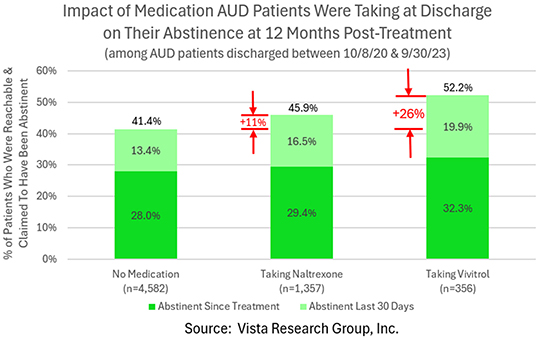
Outcomes are Substantially Better if Vivitrol is Taken for At Least Three Months
Patients Who Were Taking Vivitrol on Their Last Survey: Among patients who left treatment on Vivitrol, those who kept taking it for at least three months had substantially better abstinence rates than those who didn’t:
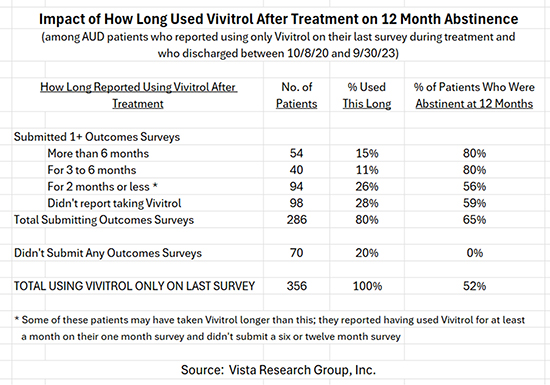
Of course, leaving treatment on Vivitrol does not mean a patient will keep taking it. Only 26% of the patients who left treatment on Vivitrol reported taking the medication for at least three months and 15% for at least six months. More than half claimed not to have taken Vivitrol at all after treatment or to have taken it for two months or less. See the reasons patients gave for stopping using Vivitrol.
Patients Who Reported Taking Vivitrol During the Post-Treatment Year: The results above are for patients who reported taking Vivitrol on their last during-treatment survey. However, there’s a second source of data we can analyze – patients who reported using Vivitrol on one or more of the surveys they submitted during their post-treatment year. Surprisingly, only 40% of these 410 patients were included in the above analysis.
This second analysis confirms the same finding – patients who remain on Vivitrol for at least three months are far more likely than those who take Vivitrol for two months or less to be abstaining from alcohol and all non-prescribed drugs at one year post-treatment:
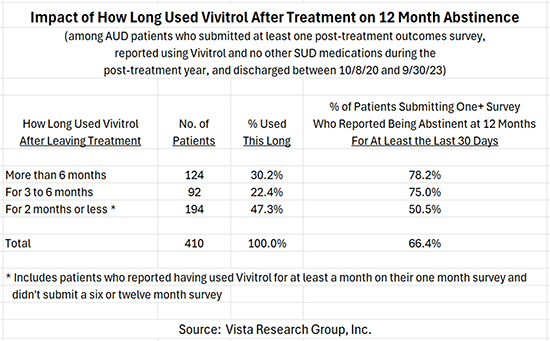
Please be aware that the column on the right overstates true abstinence rates because only patients who submitted post-treatment surveys are included in this analysis.
How Likely A Patient Is to Stay on Vivitrol

Since staying on Vivitrol for at least three months is so crucial to achieving long-term abstinence, it would be helpful to be able to predict patients for whom this will be a struggle.
Fortunately, there is a strong correlation between how happy a patient reports being with Vivitrol on their last survey before leaving treatment and how long they stay on it. Among the 63% of Vivitrol users who reported being very happy with Vivitrol on their last survey, 20% remained on Vivitrol for at least six months. By comparison, only 13% of those who said they were somewhat happy to be taking Vivitrol were taking it six months later:
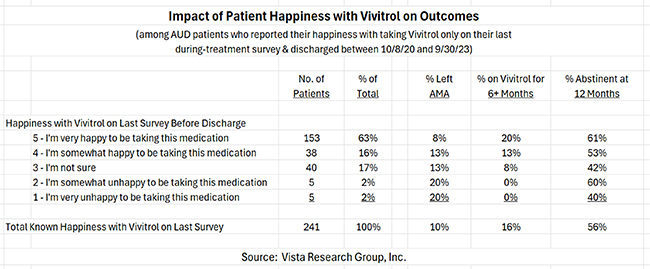
Not surprisingly, the group who were very happy to be taking Vivitrol were also more likely to be abstinent at 12 months post-treatment and less likely to have left treatment against medical advice that those who were less happy to be taking Vivitrol.
TL/DR: Key Take-Aways
Vista’s research shows that compared to patients who aren’t using a medication to manage their cravings, patients being treated for alcohol use disorder who take Vivitrol are 26% more likely to be abstaining from drinking and using illicit drugs one year after treatment. Individuals who take Vivitrol for at least three months have substantially higher one year abstinence rates than those who use it for two months or less.
For Families & Employers: When choosing a rehab for a loved one or employee with alcoholism, I’d strongly suggest checking that the rehab offers Vivitrol and encourages its usage whenever clinically appropriate.
For Treatment Professionals: This research showing that taking Vivitrol significantly increases the likelihood that an AUD patient will be able to abstain from drinking and using illicit drugs after treatment should encourage you to prescribe these medications whenever appropriate. However, if a patient says they’re unhappy taking the medication, you should consider other alternatives as they’re unlikely to keep taking it long-term.

